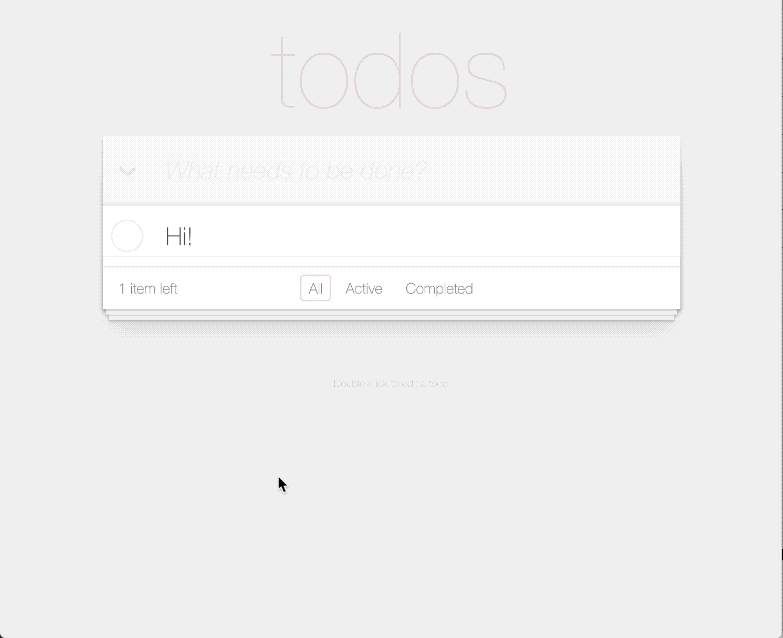|
|
||
|---|---|---|
| .idea | ||
| docs | ||
| resources/day8/re_frame/trace | ||
| src | ||
| test/day8/re_frame/trace | ||
| test-resources | ||
| .gitignore | ||
| CHANGELOG.md | ||
| DEVELOPERS.md | ||
| LICENSE | ||
| README.md | ||
| project.clj | ||
README.md
re-frame-trace
re-frame-trace is a programmer's dashboard. It helps you to see inside a running re-frame
application, allowing you to better understand it and debug it.
Note the latest version 0.1.14 ALSO requires the latest version of re-frame itself - v0.10.3-alpha2.
Helpful How?
Four ways:
- Help you to learn
re-frame. If you are new tore-frame, looking at the raw "Traces" it will assist you to understand the data flows involved (the dominoes). - Help you to explore and learn an unfamiliar
re-framecodebase. When I click on this "X" button, it shows me what event isdispatch-ed and in what namespace the associated event handler is registered. And, "oh look, that's interesting - four subscriptions recalculated". Etc. - Help you with debugging. You see an x-ray of your app's functioning.
In particular, it will assist you to write and debug
event handlers, which is useful because they hold most of the logic
in your
re-frameapps. - Helps you to find performance problems and/or detect where there is unnecessary computation occurring.
This list is aspirational.
re-frame-traceremains a WIP. We're getting there.
Epoch Oriented
re-frame applications are computationally regular. First an event happens,
and then boom, boom, boom go a series of known computational steps (dominoes),
in a known order.
At the end of it, a re-frame app lapses into a quiescent state waiting for another
event to kick off the next iteration of the same cycle.
Each re-frame event and its consequent computation forms a bounded "epoch"
which can be inspected, analysed and understood independently of other epochs. This
tool is epoch-oriented.
And, yes, it has "time travel debugger" capabilities - you can go backwards
and forwards through epochs - but that's really not the most interesting or powerful
aspect of what re-frame-trace delivers.
It is about Data
As it runs, re-frame generates detailed "trace" which is captured as data, not strings.
This trace provides an x-ray of your app's functioning.
In addition, re-frame is as much "data oriented" as it is functional in design. It "flows" data, in a loop, through the functions you provide.
So, data is at the core of re-frame-trace and that's a powerful and leverageable substrate.
Data Dashboard
Except, there's often too much data - too much detail.
So, re-frame-trace tries to be something of a "dashboard" in the sense that
it tries to turn "raw data" into "information" through curated analysis, and "roll ups"
designed to deliver insight "at a glance". But still allowing you to "drill into the detail".
Right. So, this tool an epoch-oriented, interactive data dashboard for gaining insights and assisting debugging. But, it is also a work in progress, so these magnificent descriptions run well ahead of what is delivered right now. But we're getting there.
A Visual Sampler

Installation
If you are using leiningen, modify project.clj in the following ways. When puzzling over the various possible leiningen configurations, it's often helpful to look at a sample project.clj.
-
Add re-frame-trace as a dev dependency by placing
[day8.re-frame/trace "VERSION"]within:profiles :dev :dependencies. For example::profiles {:dev {:dependencies [[some-other-package "0.0.0"] [day8.re-frame/trace "0.0.0 (see version above)"]] }} -
Locate the
:compilermap under:devand add::closure-defines {"re_frame.trace.trace_enabled_QMARK_" true}:preloads [day8.re-frame.trace.preload]
For example:
{:builds [{:id "dev" :source-paths ["src" "dev"] :compiler {... :closure-defines {"re_frame.trace.trace_enabled_QMARK_" true} :preloads [day8.re-frame.trace.preload]}}]}
cljs-devtools is not required to use re-frame-trace, but it is highly recommended.
Usage
-
Make sure you have followed all of the installation instructions above.
-
Start up your application.
-
Once it is loaded, focus the document window and press
ctrl-hto slide open the trace panel and enable tracing. -
When the panel is closed, tracing is disabled.
Use Cases
app-db
- Inspect a portion of app-db's state with the path inspector, allowing you to focus on just the parts you care about.
- Reset app-db to before an event was run to run it again, instead of resetting the whole application
- Toggle app-db before and after states for running an event, to inspect UI changes.
Timing
- Answer the question "Why is my app slow when it runs this event?"
- See whether time is spent in processing an event, or rendering the changes
Troubleshooting
- Try a
lein clean - Make sure you have followed all the installation steps.
How does it work?
re-frame is instrumented - all important activity generates trace data. re-frame-trace consumes this trace data and renders useful visualisations of the re-frame process. Currently, re-frame's tracing capabilities are in alpha and are subject to change at any time. We're testing the utility of the the trace by building an app on top.
By default, re-frame tracing is "compiled out", so it won't impose a performance cost in production. The trade-off here is that you need to explicitly enable it in development.
The preloads option (:preloads [day8.re-frame.trace.preload]) has to be set in order to automatically monkeypatch Reagent to add appropriate lifecycle hooks. Yes this is gross, and yes we will try and make a PR to reagent to add proper hooks, once we know exactly what we need. The preload namespace also injects a div containing the devtools panel into the DOM.
Developing/Contributing
If you want to work on re-frame-trace, see DEVELOPERS.md.
Citations
- open by Bluetip Design from the Noun Project
- reload by Adnen Kadri from the Noun Project
- Camera by Christian Shannon from the Noun Project
- Delete by logan from the Noun Project
- Settings by arjuazka from the Noun Project
- Wrench by Aleksandr Vector from the Noun Project
- pause by Bhuvan from the Noun Project
- play by Bhuvan from the Noun Project
- Log Out by Arthur Shlain from the Noun Project
